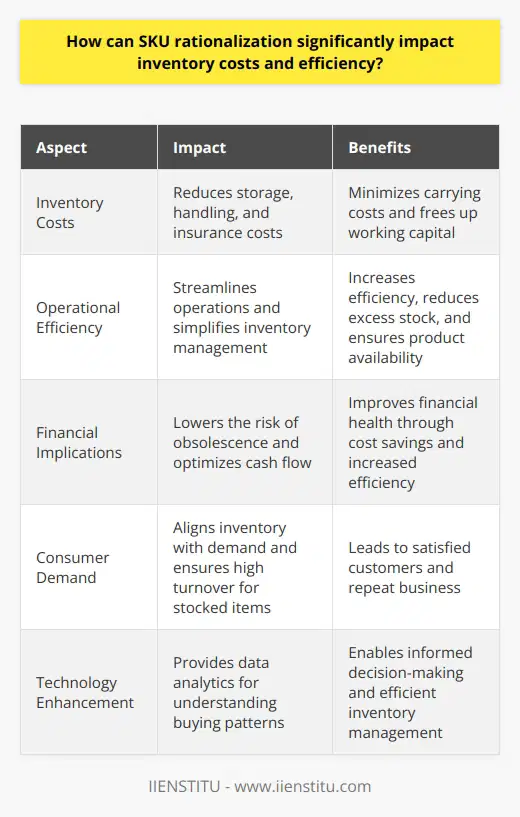
In an increasingly complex marketplace, businesses are striving to optimize their operations and sharpen their strategic focus. One approach gaining momentum is SKU (Stock Keeping Unit) Rationalization, a process aimed at enhancing product assortment efficiency by retaining profitable items and discontinuing underperforming ones.
This process not only clarifies inventory management but also aligns product offerings with consumer demand, making it a critical operation for modern businesses. The effectual implementation of SKU Rationalization can lead to streamlined operations, cost savings, and an improved bottom line. Through this article, we’ll explore the nuances of SKU Rationalization, its process, and the impacts it has on various aspects of a business.
Understanding SKU Rationalization
SKU rationalization is a decisive process in inventory management, particularly for retailers and manufacturers constantly seeking efficiency within their supply chain. By conducting a thorough analysis of product performance, businesses can identify which items are contributing to profitability and which are not. This evaluation often includes a deep dive into sales data, customer preference, and storage costs.
Detailed Explanation of SKU Rationalization: The core of SKU Rationalization lies in its capacity to streamline a company’s inventory. It is a methodical approach that scrutinizes each product’s merits, sales volume, consumer appeal, and contribution margins. By distinguishing high-performing SKUs from the less productive ones, businesses can devise a strategic product mix that maximizes their strengths and minimizes waste or redundancy.
The Role of SKU Rationalization in Inventory Control: Inventory control is inherently tied to SKU Rationalization, as excess stock or inadequate turnover can tie up capital and increase holding costs. A well-executed SKU rationalization strategy pares down the inventory to a sustainable level, ensuring that each item stocked has a justifiable place in the market and on store shelves.
How SKU Helps in Product Differentiation: In the sphere of product differentiation, SKU Rationalization serves as a compass, guiding retailers to focus on products that set them apart from the competition. By truncating the inventory to only those items that are unique, in demand, and profitable, businesses can cement their brand identity and enhance the customer shopping experience.
Case Study - An Example of Successful SKU Rationalization: To supplement the theoretical aspects of SKU Rationalization, consider the case of a major grocery chain that reduced its SKU count by 15%. By doing so, the chain noticed an increase in sales due to their ability to focus on high-demand products, and simultaneously decrease stocking costs.
The Process of SKU Rationalization
The journey of SKU Rationalization begins long before any product is discontinued. It commences with an in-depth analysis that deciphers current product performance and sets the stage for future inventory composition.
Pre-Rationalization Analysis: Understanding Product Performance: During this phase, businesses analyze sales data, customer feedback, and purchasing trends to judge the vitality of each SKU within their inventory. This information feeds into a framework that helps decide which products are indispensable and which are expendable.
Determining the Criteria for SKU Rationalization: Determining the exact criteria for SKU Rationalization is critical, as these standards will direct which items are kept or discontinued. Factors often include sales frequency, profit margin, customer loyalty, and seasonal variability.
The Process of Elimination: Deciding What Stays and What Goes - The elimination process is where businesses confront the hard truths about their inventory. Guided by data and strategic goals, companies must decide which SKUs to sustain and which to relinquish, a move that can significantly influence their operational dynamics.
Implementing the SKU Rationalization: Steps to Follow - Successfully implementing SKU Rationalization requires an orderly approach. Businesses might start by gradually phasing out the targeted SKUs, adjusting procurement practices, and communicating changes to stakeholders.
Post-Rationalization: Monitoring and Modifying - Even after the elimination of selected SKUs, it is essential for businesses to continuously monitor performance. The market can shift, new trends can emerge, and adjustments might be necessary. Hence, SKU Rationalization should be seen as a cyclical, rather than a one-off, process.
Challenges in SKU Rationalization and Solutions: The major challenges in rationalizing SKUs include potential disruptions in supplier relationships, managing customer perception, and ensuring that sales are not adversely affected. Solutions involve clear communication, maintaining strategic relationships, and data-driven decision making.
Advantages of SKU Rationalization
The benefits of a well-executed SKU Rationalization process can be wide-ranging and substantial. By honing in on the best-performing SKUs, businesses can achieve not only financial gains but also operational advantages.
Reduction in Inventory Costs: One of the primary advantages of SKU Rationalization is the reduction in inventory costs. By stocking fewer underperforming items, businesses can minimize warehousing expenses and reduce the capital tied up in inventory.
Increased Sales and Profits: Focusing on products with a higher turnover rate can lead to increased sales and, as a result, higher profits. The simplification of the product offering can also make marketing efforts more effective and efficient.
Improved Efficiencies in Supply Chain: A lean product line can streamline the supply chain operations by reducing the complexity of procurement, logistics, and distribution. This efficiency leads to faster response times and enhances the capacity to manage customer demands.
Reduction in Stock Out and Overstock Situations: With a more precise demand forecast resulting from a rationalized SKU list, businesses can better balance their inventory levels. This improved balance reduces the occurrences of stock-outs, which can frustrate customers, and overstock situations, which tie up resources.
The Impacts of SKU Rationalization on Different Business Aspects
The effects of SKU Rationalization extend beyond inventory management and influence various dimensions of a business from the supply chain to customer satisfaction.
Impact on Supply Chain Management: Rationalized SKUs allow for a more efficient supply chain, with fewer products to track, lower transportation costs, and simplified inventory monitoring.
Impact on Customer Satisfaction: Concentrating on what customers want and eliminating less popular items can boost customer satisfaction, as it simplifies the shopping experience and ensures the availability of preferred products.
Impact on Storage and Warehousing: With fewer items to store, companies can reduce warehouse space requirements, improve storage efficiency, and, in some cases, downsize to more cost-effective facilities.
SKU Rationalization and Its Relationship with Other Retail Strategies: SKU Rationalization should be integrated with other retail strategies such as category management and shopper marketing to ensure a holistic approach to inventory and sales optimization.
How SKU Rationalization Impacts Profitability and Sales: Ultimately, the success of SKU Rationalization is measured by its impact on profitability and sales. Reducing inventory bloat invariably enhances financial performance, given the right products are targeted and the process is skillfully managed.
Case Studies: Successful Applications of SKU Rationalization
It is beneficial to study real-world instances where SKU Rationalization has been successfully implemented. These case studies serve as practical references and provide critical insights into the process and its outcomes.
Case Study 1: Large Scale Retailer - A prominent example of SKU Rationalization comes from a large-scale retailer that managed to augment its sales by 5% merely by eliminating the bottom 20% of its SKU assortment, which contributed to less than 1% of sales but constituted a disproportionate amount of inventory costs.
Case Study 2: Small to Medium-Sized Enterprise - Meanwhile, a mid-sized electronics vendor applied SKU Rationalization to focus on high-margin, high-demand products and saw a 30% reduction in inventory holding costs while sustaining its revenue stream.
Learning from These Case Studies
These case studies underscore the potential of SKU Rationalization to transform a business’s operational framework. They illustrate the significant benefits that can be attained through careful implementation and continuous refinement of the process.
SKU Rationalization is a potent tool for businesses keen to refine their inventory strategy and accentuate their competitive advantage. It facilitates a strategic focus on profitable items and an enhanced customer experience, which are vitally important in the congested, ever-shifting landscape of modern retail and manufacturing. Organizations embarking on SKU rationalization processes need to grapple with data, maintain flexibility, and foster a culture of continuous improvement. Done well, SKU Rationalization can drive businesses toward a future characterized by streamlined operations, marked financial gains, and heightened market responsiveness.
Frequently Asked Questions
What are the potential benefits and challenges associated with SKU rationalization in supply chain management?
SKU Rationalization Defined
SKU rationalization refers to the process of reviewing a company's stock-keeping units (SKUs) to determine which products to keep, discontinue, or modify. It strives for an optimal assortment to maximize profitability and efficiency. This practice is crucial in supply chain management. It focuses on reducing complexity and enhancing performance.
Benefits of SKU Rationalization
Enhanced Inventory Management
Inventory optimization follows SKU rationalization. Firms see reductions in excess stock. They can also experience lower inventory costs. Streamlined inventory simplifies tracking and management operations.
Increased Efficiency
Removing slower-moving SKUs can lead to more space. This simplifies warehouse operations. Picking and packing processes thus become quicker. Overall, businesses see enhanced productivity levels.
Improved Focus on High-Value Products
SKU rationalization lets companies concentrate on lucrative products. This focus can drive more attention to higher-performing items, which might lead to better sales and profits.
Better Customer Experience
Curating a focused product offering can elevate the customer experience. Shoppers face less confusion with fewer, but more relevant, choices. This alignment can result in higher satisfaction rates.
Supply Chain Simplification
With fewer SKUs, the supply chain becomes less complex. Fewer suppliers and simpler logistics mean easier management. Relationships with suppliers often improve as well.
Challenges of SKU Rationalization
Decision-Making Complications
Identifying which SKUs to cut can be tough. These decisions need meticulous data analysis. Risk of choosing the wrong products to eliminate exists.
Resistance to Change
Internal resistance can arise. Stakeholders often fear change. Convincing them about the need for SKU rationalization can be a challenge.
Impact on Sales
A potential short-term sales dip is possible. Customers might miss discontinued products.
Supplier Relations
Reducing SKUs can affect supplier relationships. Some suppliers may lose out on business. This may require careful negotiation and management.
Complexity in Implementation
Rolling out a SKU rationalization plan involves complexity. Systems need updates. Internal teams must adapt to new processes.
Managing Customer Expectations
Customers might need education on the changes. They could need reassurance about product availability.
SKU rationalization holds potential for supply chain optimization. It offers inventory control, efficiency gains, and focus on high-value items. Yet, implementing these changes poses certain risks. The key lies in careful analysis and stakeholder management. Proper execution can solidify a company's market position and ensure long-term benefits.

How can SKU rationalization significantly impact inventory costs and efficiency?
SKU Rationalization and Inventory Management
SKU rationalization refers to the process of reviewing product offerings. It aims to identify weak performers. This process streamlines operations. It improves inventory efficiency. Rationalization helps companies reduce costs. It simplifies inventory management.
Understanding Inventory Costs
Inventory costs go beyond simple product price. They include storage, handling, and insurance. Carrying costs play a significant role. They tie up working capital. Excess inventory leads to higher costs. SKU rationalization helps minimize these costs.
Impact on Efficiency
Efficient inventory management is crucial. It ensures product availability. It also reduces excess stock. Rationalization increases efficiency in several ways:
Reduces Storage Needs: Fewer SKUs mean less space required.
Simplifies Order Picking: Employees find items faster.
Streamlines Reordering: It simplifies supplier communication.
Enhances Forecasting: Accurate predictions with fewer variables.
Financial Implications
The financial benefits are clear. Rationalization reduces carrying costs. It lowers the risk of obsolescence. It optimizes cash flow. Improved efficiency translates to cost savings.
Meeting Consumer Demand
Often, inventory meets consumer needs. SKU rationalization aligns inventory with demand. It ensures high turnover for stocked items. This leads to satisfied customers. It yields repeat business.
Technological Enhancement
Technology aids SKU rationalization. It provides data analytics. Businesses understand buying patterns better. They make informed decisions. Efficient inventory reflects smart data usage.
SKU rationalization plays a significant role. It impacts inventory costs positively. It boosts operational efficiency. Businesses experience improved financial health. Customers receive better service. Rationalization is key to strategic inventory management.

How is the process of SKU rationalization properly initiated and managed within a retail or manufacturing industry setting?
Organizations today face immense pressure. They must balance inventory costs and customer satisfaction. Stock Keeping Unit (SKU) rationalization stands out here. It is a method to handle product offerings efficiently.
Understand SKU Rationalization
SKU rationalization means reviewing. It involves analyzing product sales performance. The goal is to keep high-performing SKUs. At the same time, it eliminates poorly performing ones.
Identify Goals
First, align rationalization with company objectives. Possible goals include reducing costs or simplifying inventory. Identify these before proceeding with the process.
Gather Data
Data serves as the foundation for decisions. You must collect extensive sales data. Focus on sales velocity, profit margins, and customer preferences.
Analyze Performance
After data gathering, assess SKU performance. Employ quantitative methods. Look for patterns and trends in the data collected.
Begin the Rationalization Process
Cross-Functional Team Formation
Assemble a skilled team. It should comprise members from various departments. Their diverse perspectives will enrich the process.
Apply ABC Analysis
Next, categorize SKUs using ABC analysis. 'A' items are high priority. 'C' items are lower priority. This helps prioritize efforts effectively.
Make Data-Driven Decisions
Rely on the analysis conducted. It will guide elimination or retention choices for SKUs.
Consider Supply Chain Impact
Assess how changes affect the supply chain. Factor in lead times and supplier relationships.
Continuous Management
Review Regularly
Rationalization is not a one-time event. Schedule periodic reviews. This ensures continual alignment with market trends.
Adjust to Market Changes
Stay responsive to market shifts. Update the SKU assortment accordingly. Always remain dynamic in strategy application.
Monitor Key Metrics
Track inventory turn rates and profitability. These metrics reflect the success of SKU rationalization.
SKU rationalization is vital for optimized inventory. It begins with goals and robust data collection. Analysis guides the rationalization decisions. A team-based approach adds value. Continual management ensures lasting benefits. Follow these steps for successful SKU rationalization.



